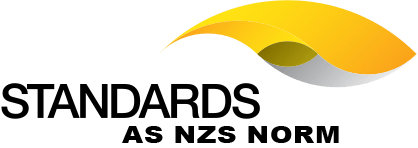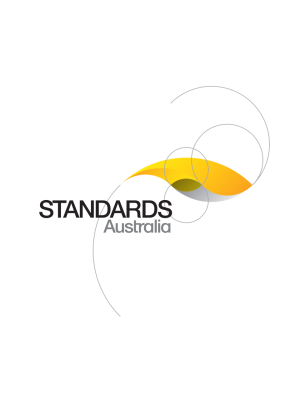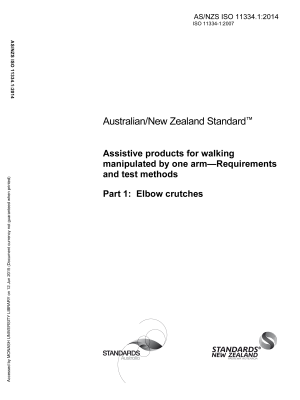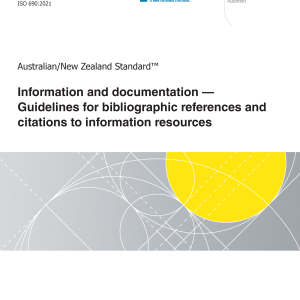🔍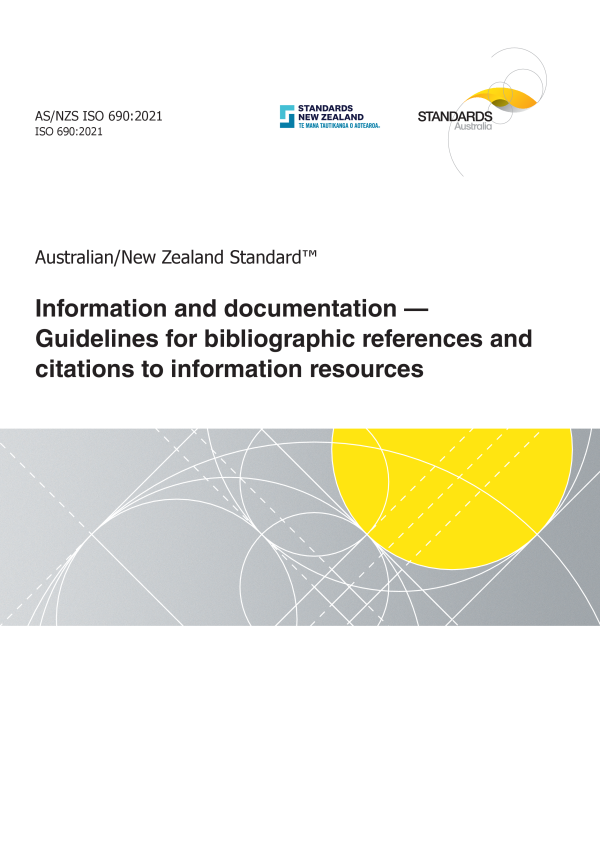

Purchase the full subscription package now and enjoy a 40% discount, along with free updates for future editions.
AS/NZS ISO 690:2021
$355.36
Information and documentation — Guidelines for bibliographic references and citations to information resources
AS/NZS ISO 690:2021 identically adopts ISO 690:2021 which describes a set of principles, guidelines, and requirements for the preparation of bibliographic references and citations in works that are not themselves primarily bibliographical.
Table of contents
Header
About this publication
Preface
Foreword
Introduction
1 Scope
2 Normative references
3 Terms and definitions
4 Principles for creating references
4.1 Purpose
4.2 Principle 1: Ensure metadata accuracy
4.3 Principle 2: Prioritize identification and retrieval
4.4 Principle 3: Unify reference presentation
4.5 Principle 4: Determine appropriate specificity
5 Guidelines for creating references
5.1 General
5.2 Facilitate location of the cited information resource
5.3 Reflect the content used accurately
5.4 Reference derivative works alongside the original
5.5 Faithfully reference the manifestation and item
5.6 Consider retrievability of unpublished information resources
5.7 Adopt a uniform presentation scheme
5.8 Accurately indicate specificity level
6 Metadata
6.1 General
6.2 Data source
6.2.1 General
6.2.2 Cited information resource
6.2.3 External metadata sources
6.3 Verifying correctness and completeness
6.4 Handling conflicting data
7 Data elements
7.1 General
7.1.1 Architecture of a citation
7.1.1.1 Types of data elements
7.1.1.2 Order of data elements
7.1.1.3 Elements and attributes
7.1.2 Common rules
7.1.2.1 General
7.1.2.2 Readability and understandability of references
7.1.2.3 Abbreviation
7.1.2.4 Rendering system and rules
7.1.2.4.1 General
7.1.2.4.2 Explicit notation
7.1.2.4.3 Implicit notation
7.1.2.5 Associated information
7.1.2.6 Supplied information
7.1.3 Manifestation and item
7.1.3.1 General
7.1.3.2 Manifestation
7.1.3.3 Item
7.2 Creator
7.2.1 General
7.2.2 Roles
7.2.3 Selection
7.2.4 Personal names
7.2.4.1 General
7.2.4.2 Variant forms
7.2.4.3 Additions
7.2.5 Organization or group names
7.2.5.1 Form of name
7.2.5.2 Disambiguation of names
7.2.5.3 Subordinate body
7.2.5.4 Parent body
7.2.6 Multiple creators
7.2.6.1 Up to five creators
7.2.6.2 More than five creators
7.2.6.3 Title first
7.2.6.4 Conferences
7.2.6.5 Subsidiary creator
7.2.6.6 Originators of multiple editions
7.2.6.7 Derivative work creator
7.2.7 Pseudonyms
7.2.8 Anonymous works
7.3 Title
7.3.1 Preferred form
7.3.2 Alternative forms
7.3.3 Popular or original title
7.3.4 Long title
7.3.5 Additional title parts
7.3.6 Ambiguous or incorrect title
7.3.7 No title
7.3.8 Translated title
7.3.9 Titles of translated works
7.3.10 Representation
7.4 Component parts
7.4.1 General
7.4.2 Representation
7.4.2.1 General
7.4.2.2 Serials
7.4.2.3 Emphasis to facilitate location
7.5 Formats and resource types
7.5.1 Formats
7.5.2 Resource types
7.5.2.1 General
7.5.2.2 Content type
7.5.2.3 Carrier type
7.5.3 Digital file formats
7.5.4 Migrated medium
7.6 Edition and version
7.6.1 Edition
7.6.2 Version
7.6.3 Differentiated and adaptive content
7.6.4 Publication stages
7.7 Date
7.7.1 General
7.7.2 Representation
7.7.2.1 Year
7.7.2.2 Season, month, day, time
7.7.2.3 Uncertain, unknown, approximate or missing date
7.7.2.4 Date ranges
7.7.3 Date of publication
7.7.4 Date of citation
7.7.5 Reissuance and surrogate dates
7.7.6 Incorrect dates
7.8 Production information
7.8.1 General
7.8.2 Roles
7.8.2.1 General
7.8.2.2 Publisher
7.8.2.3 Multiple roles
7.8.2.4 Film studio, production company, distributor, issuing body or online host
7.8.2.5 Printer or manufacturer
7.8.2.6 Sponsor
7.8.3 Place
7.8.3.1 General
7.8.3.2 Place identifiers
7.8.3.3 Multiple places
7.8.3.4 Unknown place
7.9 Numeration and pagination
7.9.1 General
7.9.2 Part cited
7.9.3 Plain citations and references
7.10 Serials and series
7.10.1 General
7.10.2 Qualifiers for titles
7.10.3 Key title and the abbreviated key title
7.10.4 Earlier titles
7.10.5 Conference information
7.10.6 Series title and numbering
7.10.7 New series
7.11 Identifiers
7.11.1 General
7.11.2 International standard identifiers
7.11.3 Persistent identifiers
7.12 Availability and location
7.12.1 Physical location
7.12.1.1 General
7.12.1.2 Place and repository
7.12.1.3 Privately-owned information resources
7.12.2 Network location and access
7.12.2.1 General
7.12.2.2 Network access
7.12.2.3 Related locations
7.12.2.4 Archival access
7.12.2.5 Specific versions
7.12.2.6 Nonspecific versions
7.12.2.7 Representing long URIs
7.12.2.8 Providing navigation path instead of full URI
7.12.2.9 Providing PID
7.12.2.10 Outdated location information
7.12.3 Permanent links and URL shorteners
7.12.4 Access restrictions and extinct resources
7.13 Item and event attributes
7.13.1 General
7.13.2 Item attributes
7.13.3 Event attributes
7.14 Relationship
7.14.1 General
7.14.2 Translation
7.14.3 Commentary
7.14.4 Annotated editions
7.14.5 Arranger
7.14.6 Abridgement and adaptation
7.14.7 Reviews and critiques
7.14.8 Surrogate
7.14.9 Inclusion
7.14.10 Performance
7.14.11 Multiple relationships
7.15 Other elements
7.15.1 General
7.15.2 Subject
7.15.3 Dimensions and size
7.15.4 File size
7.15.5 Price
7.15.6 Registered trademark
7.15.7 Rights metadata
7.15.8 Provenance and authenticity
7.15.9 System requirements
7.15.10 Restoration
7.15.11 Other information
8 Resource categories
8.1 General
8.1.1 Purpose
8.1.2 Metadata elements to display
8.2 Monographs
8.2.1 Metadata elements
8.2.2 Simple monographs
8.2.3 Composed of multiple volumes
8.2.4 E-books
8.2.5 Audiobooks
8.2.6 Plays, librettos and scripts
8.2.7 Item
8.3 Monograph components
8.3.1 Metadata elements
8.3.2 Component parts of a monograph
8.4 Serials and their component parts
8.4.1 General
8.4.2 Metadata elements
8.4.2.1 Referencing an entire serial or entire issue of a serial
8.4.2.2 Referencing a component part within a serial
8.4.3 Serials and their component parts
8.4.4 Newspaper articles
8.4.5 Monograph series and their component parts
8.5 Programs and applications
8.5.1 General
8.5.2 Metadata elements
8.5.3 Data elements and guidance specific to type
8.5.3.1 Creator
8.5.3.2 Date of publication
8.5.3.3 Edition and version
8.5.3.4 License
8.5.3.5 Additional information
8.5.4 Operating systems
8.5.5 General programs
8.5.6 Games
8.6 Cartographic material
8.6.1 General
8.6.2 Metadata elements
8.6.3 Data elements and guidance specific to type
8.6.3.1 Title
8.6.3.2 Subject and area covered
8.6.3.3 Roles
8.6.3.4 Series designation
8.6.3.5 Scale
8.6.3.6 Size
8.6.3.7 Spectral characteristics
8.6.3.8 Additional information
8.6.4 Separately issued cartographic resources
8.6.5 As a component part
8.6.6 Electronic cartographic resources
8.7 Events, performances, recordings and audio-visual materials
8.7.1 General
8.7.2 Metadata elements
8.7.2.1 Events and performances
8.7.2.2 Recordings and audio-visual material
8.7.3 Data elements and guidance specific to type
8.7.3.1 Persistent identifiers
8.7.3.2 Creators
8.7.3.3 Date of transmission
8.7.3.4 Format and resource type
8.7.4 Motion pictures and videos
8.7.5 Broadcasts
8.7.6 Component parts
8.7.7 Performance, productions and events
8.7.8 Performance recordings
8.7.9 Performance-related artefacts
8.7.10 Exhibitions
8.8 Art, graphic material and collectables
8.8.1 General
8.8.2 Metadata elements
8.8.3 Data elements and guidance specific to type
8.8.3.1 Title
8.8.3.2 Roles
8.8.3.3 Location
8.8.3.4 Size
8.8.3.5 Catalogue and exhibition identifiers
8.8.3.6 Format
8.8.4 Individual works
8.8.5 As a component part
8.8.6 Permanent structures and installations
8.8.7 Temporary or destroyed work
8.9 Music material
8.9.1 General
8.9.2 Metadata elements
8.9.3 Data elements and guidance specific to type
8.9.3.1 Title
8.9.3.2 Creator
8.9.4 Performed and recorded music
8.9.5 Musical score
8.9.6 As a component part
8.10 Patents
8.10.1 General
8.10.2 Metadata elements
8.10.3 Data elements and guidance specific to type
8.10.3.1 Type
8.10.3.2 Patent application country
8.10.3.3 Patent inventors
8.10.3.4 Additional information
8.10.3.5 Patent number
8.10.4 Patent applications
8.10.5 Issued patents
8.11 Reports in series and similar information resources
8.11.1 General
8.11.2 Metadata elements
8.11.3 Data elements and guidance specific to type
8.11.3.1 Series title
8.11.3.2 Edition
8.11.4 Standards
8.11.4.1 General
8.11.4.2 Jointly published standards
8.11.4.3 Dual-published standards
8.11.4.4 Draft standards
8.11.4.5 Adopted standards
8.11.4.6 Multi-part standards and standard series
8.11.4.7 Amendments and corrigenda
8.12 Archival materials
8.12.1 General
8.12.2 Metadata elements
8.12.3 Data elements and guidance specific to type
8.12.3.1 Title
8.12.3.2 Creator
8.12.3.3 Name of the fonds/collection and location within the collection
8.12.4 Individual documents
8.12.5 Collections
8.12.6 Privately-owned documents and ephemera
8.13 Research datasets
8.13.1 General
8.13.2 Metadata elements
8.13.3 Data elements and guidance specific to type
8.13.3.1 License
8.13.3.2 Roles
8.13.3.3 Persistent identifiers
8.13.3.4 Linked resources
8.13.3.5 File size
8.13.3.6 Dataset and publications
8.13.3.7 Provenance information
8.13.3.8 Edition and version
8.13.3.9 Surrogates
8.14 Web sites and their component parts
8.14.1 General
8.14.2 Metadata elements
8.14.3 Data elements and guidance specific to type
8.14.3.1 Title
8.14.3.2 System requirements
8.14.3.3 Archive reference
8.14.3.4 Edition or version
8.14.4 Web site
8.14.5 Web archives
8.14.6 Web page
8.14.7 Component part of a Web page
8.15 Social media and services
8.15.1 General
8.15.2 Metadata elements
8.15.3 Data elements and guidance specific to type
8.15.3.1 Creator
8.15.3.2 Title
8.15.3.3 Medium
8.15.3.4 Service name and medium
8.15.3.5 Date
8.15.3.6 Network location
8.15.3.7 Archived copy
8.15.4 Services
8.15.5 Stream of records
8.15.6 Individual records
8.15.7 Posting of content belonging to an original creator
8.16 Unpublished information resources
8.16.1 General
8.16.2 Metadata elements
8.16.3 Data elements and guidance specific to type
8.16.3.1 Resource type and location
8.16.4 Personal communications
8.16.5 Group communications
8.16.6 Dissertations and theses
8.16.7 Manuscript
8.16.8 Preprint
8.16.9 Phone calls
8.16.10 Presentation
Annex A
A.1 General
A.1.1 Linking citations to references
A.1.2 Reference list arrangement order
A.2 Name and date system (Harvard system)
A.2.1 General
A.2.2 Citation in text
A.2.3 References
A.2.3.1 General
A.2.3.2 Example reference list with name and date system
A.3 Numeric system
A.3.1 Citation in text
A.3.2 References
A.3.2.1 General
A.3.2.2 Example reference list with numerals and full stop
A.3.2.3 Example reference list with numerals in brackets
A.4 Named tag system
A.4.1 Citation in text
A.4.2 References
A.4.2.1 General
A.4.2.2 Example reference list with named tags
A.5 Running notes
A.5.1 Citation in text
A.5.2 References
A.5.2.1 General
A.5.2.2 Example reference list with running notes
A.6 Implied system
A.6.1 Citation in text
A.6.2 References
A.6.2.1 General
A.6.2.2 Using the implied system with other citation systems
A.6.2.3 Example reference list exclusively using implied system
A.6.2.4 Example reference list using the implied system with another system
Annex B
B.1 General
B.2 Options for referencing Web resources
B.2.1 General
B.2.2 PID systems
B.2.3 Permanent link systems
B.2.4 Web citation services
B.2.5 Web archives
B.3 Trust
Bibliography
Cited references in this standard
Please select a variation to view its description.
| Published | 22/10/2021 |
|---|---|
| Pages | 190 |
Please select a variation to view its pdf.
